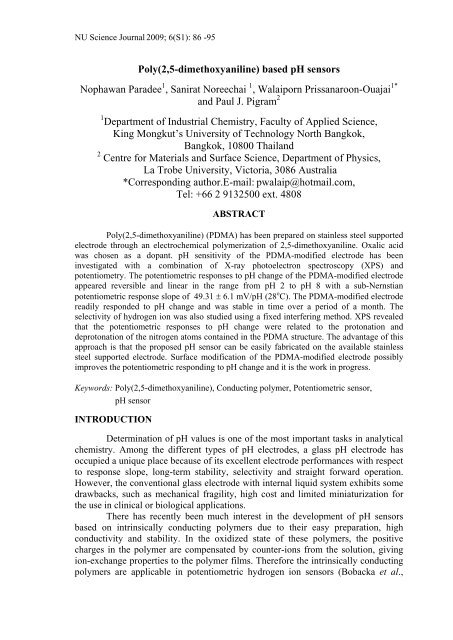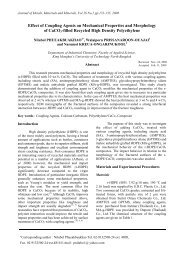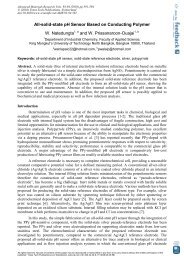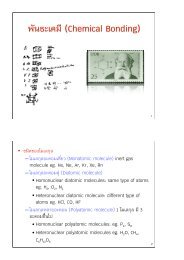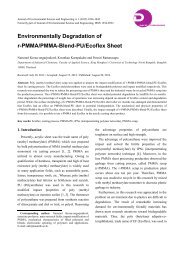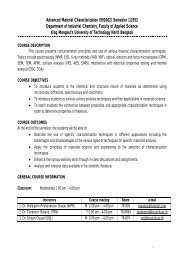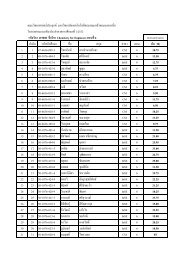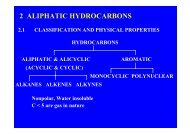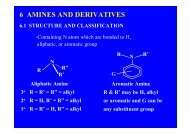Poly(2,5-dimethoxyaniline) based pH sensors Nophawan Paradee ...
Poly(2,5-dimethoxyaniline) based pH sensors Nophawan Paradee ...
Poly(2,5-dimethoxyaniline) based pH sensors Nophawan Paradee ...
Create successful ePaper yourself
Turn your PDF publications into a flip-book with our unique Google optimized e-Paper software.
NU Science Journal 2009; 6(S1): 86 -95<br />
<strong>Poly</strong>(2,5-<strong>dimethoxyaniline</strong>) <strong>based</strong> <strong>pH</strong> <strong>sensors</strong><br />
<strong>Nophawan</strong> <strong>Paradee</strong> 1 , Sanirat Noreechai 1 , Walaiporn Prissanaroon-Ouajai 1*<br />
and Paul J. Pigram 2<br />
1 Department of Industrial Chemistry, Faculty of Applied Science,<br />
King Mongkut’s University of Technology North Bangkok,<br />
Bangkok, 10800 Thailand<br />
2 Centre for Materials and Surface Science, Department of Physics,<br />
La Trobe University, Victoria, 3086 Australia<br />
*Corresponding author.E-mail: pwalaip@hotmail.com,<br />
Tel: +66 2 9132500 ext. 4808<br />
ABSTRACT<br />
<strong>Poly</strong>(2,5-<strong>dimethoxyaniline</strong>) (PDMA) has been prepared on stainless steel supported<br />
electrode through an electrochemical polymerization of 2,5-<strong>dimethoxyaniline</strong>. Oxalic acid<br />
was chosen as a dopant. <strong>pH</strong> sensitivity of the PDMA-modified electrode has been<br />
investigated with a combination of X-ray photoelectron spectroscopy (XPS) and<br />
potentiometry. The potentiometric responses to <strong>pH</strong> change of the PDMA-modified electrode<br />
appeared reversible and linear in the range from <strong>pH</strong> 2 to <strong>pH</strong> 8 with a sub-Nernstian<br />
potentiometric response slope of 49.31 ± 6.1 mV/<strong>pH</strong> (28 o C). The PDMA-modified electrode<br />
readily responded to <strong>pH</strong> change and was stable in time over a period of a month. The<br />
selectivity of hydrogen ion was also studied using a fixed interfering method. XPS revealed<br />
that the potentiometric responses to <strong>pH</strong> change were related to the protonation and<br />
deprotonation of the nitrogen atoms contained in the PDMA structure. The advantage of this<br />
approach is that the proposed <strong>pH</strong> sensor can be easily fabricated on the available stainless<br />
steel supported electrode. Surface modification of the PDMA-modified electrode possibly<br />
improves the potentiometric responding to <strong>pH</strong> change and it is the work in progress.<br />
Keywords: <strong>Poly</strong>(2,5-<strong>dimethoxyaniline</strong>), Conducting polymer, Potentiometric sensor,<br />
<strong>pH</strong> sensor<br />
INTRODUCTION<br />
Determination of <strong>pH</strong> values is one of the most important tasks in analytical<br />
chemistry. Among the different types of <strong>pH</strong> electrodes, a glass <strong>pH</strong> electrode has<br />
occupied a unique place because of its excellent electrode performances with respect<br />
to response slope, long-term stability, selectivity and straight forward operation.<br />
However, the conventional glass electrode with internal liquid system exhibits some<br />
drawbacks, such as mechanical fragility, high cost and limited miniaturization for<br />
the use in clinical or biological applications.<br />
There has recently been much interest in the development of <strong>pH</strong> <strong>sensors</strong><br />
<strong>based</strong> on intrinsically conducting polymers due to their easy preparation, high<br />
conductivity and stability. In the oxidized state of these polymers, the positive<br />
charges in the polymer are compensated by counter-ions from the solution, giving<br />
ion-exchange properties to the polymer films. Therefore the intrinsically conducting<br />
polymers are applicable in potentiometric hydrogen ion <strong>sensors</strong> (Bobacka et al.,
87 NU Science Journal 2009; 6(S1)<br />
2008). <strong>Poly</strong>pyrrole and polyaniline have attracted the most attention since the<br />
protonation-deprotonation processes of amino groups contained in the structures are<br />
expected to impart <strong>pH</strong> responses (Yuqing et al., 2005). The conducting polymer<strong>based</strong><br />
<strong>pH</strong> <strong>sensors</strong>, however, have suffered from long response time, nonreproducibility<br />
and salt effect (Prissanaroon et al., 2004; Lakard et al., 2007).<br />
Attempts to improve the potentiometric responses to <strong>pH</strong> changes of the conducting<br />
polymer-<strong>based</strong> <strong>pH</strong> <strong>sensors</strong> have been reported. Chemical incorporation of a<br />
quinhydrone functionality, a well-known molecular charge-transfer complex<br />
consisting of a combination of benzoquinone and hydroquinone, into a thin film of<br />
conducting polypyrrole has been reported by Aquino-Binag et al. (1996). The<br />
potentiometric characteristics of the hydroquinone-functionalized PPy film showed a<br />
sub-Nernstian response of 46 mV/<strong>pH</strong> at 25<br />
o C and allowed fabrication<br />
reproducibility. Recently, Prissanaroon-Ouajai et al. (2008) have reported that the<br />
polypyrrole doped with hydroquinone monosulfonate, a functional dopant with<br />
quinhydrone-like structure, showed an improved potentiometric response of 50.54<br />
mV/<strong>pH</strong> (28 o C) and a response time less than 100 seconds.<br />
In the present study, poly(2,5-<strong>dimethoxyaniline</strong>) (PDMA) film have been<br />
electrochemically synthesized on the stainless steel supported electrode and used as<br />
a <strong>pH</strong> sensor. PDMA has been selected because PDMA is possibly converted to<br />
poly(2,5-dihydroxyaniline) through the demethylation of methoxy groups in the 2,5-<br />
<strong>dimethoxyaniline</strong> units, resulting in the redox activity which is analogous to that of<br />
quinhydrone in aqueous electrolyte (Morita et al., 1995) and this is on-going work.<br />
Oxalic acid has been used as a dopant as it able to passivate the stainless steel via the<br />
formation of iron oxalate layer, leading to strongly adherent and smooth polymer<br />
film onto a stainless steel electrode (Prissanaroon et al., 2006). The PDMA surfaces<br />
were characterization by X-ray photoelectron spectroscopy (XPS). The sensitivity of<br />
the PDMA-<strong>based</strong> <strong>pH</strong> sensor was investigated using a potentiometric technique.<br />
EXPERIMENTAL<br />
PDMA film has been synthesized via a potentiostatically<br />
electropolymerization. The supported electrodes were made of stainless steel rods<br />
(Grade 430) fitted into Teflon tubes with an active coating area of 0.078 cm 2 and<br />
were as working and auxiliary electrodes. Prior each synthesis, the electrodes were<br />
mechanically polished thoroughly with alumina, rinsed with deionized water and<br />
subsequently cleaned in an ultrasonic bath for 3 minutes. The electrolyte solution<br />
contained 2,5-<strong>dimethoxyaniline</strong> (0.125 M) and oxalic acid (1.0 M). The<br />
electropolymerization was performed using a GW Instek Power Supply (Model GPC<br />
3030D, Taiwan) in a one-compartment cell with a constant applied potential of 1.2<br />
V for 10 minutes at room temperature (28 o C). The PDMA-coated electrode was<br />
then removed from solution and washed thoroughly with copious amounts of<br />
deionized water to eliminate any loosely bound species. The electrode was dried in a<br />
desiccator before further characterization and testing.<br />
The PDMA surfaces before and after treated with different buffer solutions<br />
were investigated by XPS using a Kratos Axis Ultra DLD spectrometer with a<br />
monochromatised Al Kα radiation source (hν = 1486.6 eV) operating at 150 W.
NU Science Journal 2009; 6(S1) 88<br />
Survey and high-resolution region spectra were recorded at analyzer pass energies of<br />
160 eV and 20 eV, respectively. A low-energy electron flood source as used to<br />
counter surface charging during spectral acquisitions, and spectra were corrected for<br />
charge shifting by referencing to the C–C component of the C 1s peak<br />
(E b = 285. eV).<br />
Potentiometric measurements were conducted using a 2700 digital<br />
multimeter/data acquisition system (Keithley, USA). The PDMA-modified electrode<br />
was conditioned in 0.1M oxalic acid overnight and rinsed thoroughly with deionized<br />
water before use as an indicating electrode. Standard buffer solutions of different <strong>pH</strong><br />
values were prepared with appropriate mixtures of citric acid (Ajax), boric acid<br />
(Ajax) and Na 3 PO 4 .10H 2 O (Sigma-Aldrich) (Perrin and Dempsey, 1974). The opencircuit<br />
potentials (E cell ) of the electrode were recorded against an Ag/AgCl reference<br />
electrode. A calibration curve was constructed by plotting the E cell (mV), against the<br />
<strong>pH</strong> value of the buffer solution. Electrode selectivity was evaluated in the presence<br />
of various interfering ions following the IUPAC recommendation that the interfering<br />
ion concentration was kept constant at 0.01 M and the <strong>pH</strong> was varied. The<br />
selectivity coefficient (K ij ) was estimated using the extended Nernstian equation<br />
(Buck and Linder, 1994). The electrode stability was monitored by repeatedly<br />
introducing the electrode into the buffer solutions, measuring the potentials and<br />
storing the electrode in the conditioning solution.<br />
RESULTS AND DISCUSSION<br />
1. Surface Characterization of the PDMA-modified Electrodes<br />
Typical XPS survey spectrum for the PDMA surface is presented in Figure<br />
1 showing the expected elemental composition of PDMA including carbon, oxygen<br />
and nitrogen. No signal of stainless steel electrode could be detected indicating<br />
complete coverage of PDMA.<br />
x 10 4<br />
10<br />
O 1s 1s<br />
8<br />
C<br />
1s<br />
1s<br />
CPS<br />
6<br />
4<br />
C KLL<br />
O KLL<br />
N 1s<br />
2<br />
1400 1200 1000 800 600 400 200 0<br />
Binding Energy (eV)<br />
Figure 1 Typical XPS survey spectrum for PDMA surface
89 NU Science Journal 2009; 6(S1)<br />
Response to <strong>pH</strong> change of the PDMA-modified electrodes was studied by<br />
immersing the PDMA films in different buffer solutions. Table 1 presents the<br />
elemental compositions derived from XPS survey spectra. The N 1s photoelectron<br />
spectra of the PDMA films before and after immersion in buffer solutions, together<br />
with their fitted peak components are illustrated in Figure 2 and the compositions of<br />
various nitrogen species are summarized in Table 1. For the as-prepared PDMA film<br />
(Figure 2a), the N 1s spectrum is deconvoluted into three components. A major<br />
component at 399.5 eV is attributed to the amine-like nitrogen (-NH-). Two other<br />
components with binding energies at 400.5 eV and 401.8 eV are associated with<br />
positively charged nitrogen species, N + and N 2+ respectively, indicating that the asprepared<br />
PDMA film is in the conducting state (Prissanaroon et al., 2002). The<br />
similar fitting is observed for the PDMA film after immersing in acid (Figure 2b),<br />
however the positively nitrogen species appear to be more dominant suggesting a<br />
higher doping level.<br />
A new peak located at 398.0 eV, attributed to imine-like nitrogen (-N=), is<br />
detected for the PDMA film after immersing in the solution of <strong>pH</strong> 7 (Figure 2c)<br />
(Prissanaroon et al., 2004). When the PDMA film is treated with a base (Figure 2d),<br />
the intensity of the imine-like nitrogen increases, resulting in a 25% deprotonated<br />
PDMA base ([-N=] = 25%) which is considered to be a complete deprotonation (Su<br />
and Iroh, 1998). Therefore, it is proposed that the <strong>pH</strong> sensitivity of PDMA films<br />
involves protonation-deprotonation at the 2,5-<strong>dimethoxyaniline</strong> moieties contained<br />
in the PDMA chains of the polymer and hydrogen ion exchange processes in the<br />
polymer, represented by a proposed mechanism in Figure 3.<br />
Table 1 Relative compositions of the PDMA surfaces evaluated from survey XPS<br />
spectra and high-resolution N 1s photoelectron spectra<br />
Sample<br />
XPS survey spectra<br />
(Atomic %)<br />
High-resolution N 1s spectra<br />
(Atomic %)<br />
O 1s N 1s C 1s -N= -NH- N + N ++<br />
PDMA as-prepared 25.6 5.9 68.6 - 64.8 25.6 9.6<br />
PDMA treated with <strong>pH</strong> 3 29.0 5.5 65.5 - 57.7 27.8 14.5<br />
PDMA treated with <strong>pH</strong> 7 25.4 6.4 68.2 7.8 57.6 18.2 16.4<br />
PDMA treated with <strong>pH</strong> 10 21.6 8.1 70.3 24.8 42.6 20.9 11.7
NU Science Journal 2009; 6(S1) 90<br />
Figure 2 High-resolution N 1s photoelectron spectra of PDMA surfaces; (a) asprepared<br />
and after immersed in different buffer solutions of (b) <strong>pH</strong> 3, (c)<br />
<strong>pH</strong> 7 and (d) <strong>pH</strong> 10<br />
*<br />
H 3 CO<br />
OCH 3<br />
NH<br />
A<br />
H 3 CO<br />
OCH 3<br />
NH *<br />
- H + A -<br />
- e -<br />
+ H + A -<br />
+ e -<br />
*<br />
H 3 CO<br />
OCH 3<br />
N<br />
H 3 CO<br />
OCH 3<br />
N<br />
*<br />
Figure 3 A proposed mechanism of acid-base treatment of PDMA involving a<br />
protonation-deprotonation process
91 NU Science Journal 2009; 6(S1)<br />
2. Potentiometric Measurements of PDMA-modified Electrodes<br />
2.1 Potentiometric Responses to <strong>pH</strong> Change<br />
Figure 4 presents the calibration plot of the PDMA-modified electrode. A<br />
response slope was found to be a sub-Nernstian slope of 49.31 ± 6.1 mV/<strong>pH</strong> (28 o C)<br />
with the linear regression correlation coefficients greater than 0.997 over the <strong>pH</strong><br />
range of 2 to 8. The evolution of potential as a function of measuring time for the<br />
PDMA-modified electrode in buffer solutions revealed that approximately 98% of<br />
the steady response occurred in less than 10 seconds indicating a short response time<br />
of the PDMA-modified electrode. As seen in Figure 4, however, a large deviation is<br />
observed above <strong>pH</strong> 8. This suggests that the PDMA-modified electrode may not be<br />
an effective <strong>pH</strong> sensor for basic solutions.<br />
E (mV) vs. Ag/AgCl<br />
250<br />
200<br />
150<br />
100<br />
50<br />
0<br />
-50<br />
-100<br />
-150<br />
-200<br />
-250<br />
0 1 2 3 4 5 6 7 8 9 10 11 12 13<br />
<strong>pH</strong><br />
Figure 4 Potentiometric responses to <strong>pH</strong> change of the PDMA-modified electrodes<br />
A comparison of <strong>pH</strong> measurements in various solutions, including buffer <strong>pH</strong><br />
4, buffer <strong>pH</strong> 7, Pepsi, Sponsor, orange juice and water, was performed using the<br />
PDMA-modified electrode and a commercial glass <strong>pH</strong> electrode. It can be seen in<br />
Table 2 that the PDMA-modified electrode shows an acceptable difference for all<br />
tested solutions, except water. It is important to note that the PDMA-modified<br />
electrode is not suitable for basic solution as mentioned earlier.
NU Science Journal 2009; 6(S1) 92<br />
Table 2 <strong>pH</strong> values obtained for various solutions with the PDMA-modified<br />
electrode and the glass <strong>pH</strong> electrode<br />
<strong>pH</strong> value<br />
Solution Glass <strong>pH</strong> electrode PDMA-modified<br />
electrode<br />
<strong>pH</strong> difference<br />
Pepsi 2.407 2.54 0.133<br />
Sponsor 3.203 4.60 1.397<br />
Orange juice 3.656 3.23 -0.426<br />
Buffer <strong>pH</strong> 4 4.010 4.10 0.090<br />
Buffer <strong>pH</strong> 7 7.000 5.50 -1.500<br />
Water 7.922 5.00 -2.922<br />
2.2 Electrode Selectivity<br />
Selectivity of the PDMA-modified electrode was investigated by repeating<br />
the experiments with addition of some common interfering ions following the fixed<br />
interfering method (Buck and Linder, 1994). The calibration curves of the PDMAmodified<br />
electrodes in the presences of interfering ions are shown in Figure 5. The<br />
potentiometric selectivity coefficients (K ij ), quantified by evaluation of following the<br />
IUPAC recommendation, are summarized in Table 3. It is apparent that most<br />
interfering ions do not exhibit a large effect on the potentiometric response of the<br />
PDMA-modified electrode as selectivity coefficients are small. However, serious<br />
influences of <strong>pH</strong> sensitivity, including the large deviation from the calibration curve<br />
and relatively high selectivity coefficient, are observed for Zn 2+, Al 3+ and SO 4 2- .<br />
Figure 5 Influence of (a) cationic and (b) anionic interfering ions on the<br />
potentiometric responses of the PDMA-modified electrodes.
93 NU Science Journal 2009; 6(S1)<br />
Table 3 Selectivity coefficients of the PDMA-modified electrode in the presence of<br />
various interfering ions<br />
Interfering ions<br />
Selectivity coefficient<br />
None -<br />
Zn 2+ 3.16 × 10 -2<br />
Mg 2+ 3.16 × 10 -4<br />
Na + 1.00 × 10 -7<br />
Al 3+ 3.33 × 10 -3<br />
2-<br />
SO 3 1.58 × 10 -5<br />
2-<br />
SO 4 1.58 × 10 -3<br />
-<br />
NO 3 1.00 × 10 -9<br />
Cl - 1.00 × 10 -7<br />
2.3 Electrode Stability<br />
Potentiometric response of the PDMA-modified electrode was examined<br />
over a period of 43 days in order to study the stability of electrode. As seen in Figure<br />
6, the calibration curves of the PDMA-modified electrodes remain linear and the<br />
response slopes are close to the fresh electrode (1 st day) even after repeatedly using<br />
for 20 days. A significant decrease in response slope is observed for the PDMAmodified<br />
electrode after 28 days of the first use. It is important to note that the<br />
PDMA film was found to peel off the supported electrode and it is a possible reason<br />
for the change of response slope.<br />
E (mV) vs Ag/AgCl<br />
250<br />
200<br />
150<br />
100<br />
50<br />
0<br />
-50<br />
-100<br />
-150<br />
Day 1<br />
Day 4<br />
Day 9<br />
Day 14<br />
Day 21<br />
Day 28<br />
Day 36<br />
Day 43<br />
0 2 4 6 8 10<br />
<strong>pH</strong><br />
Figure 6 Influence of aging time on the potentiometric responses of the PDMAmodified<br />
electrodes
NU Science Journal 2009; 6(S1) 94<br />
CONCLUSION<br />
PDMA-modified electrode has been simply fabricated via a one-step<br />
electropolymerization of 2,5-<strong>dimethoxyaniline</strong> on stainless steel. The potentiometric<br />
sensitivity to <strong>pH</strong> change of the PDMA-modified electrode exhibits a response slope<br />
of 49.31 ± 6.10 mV/<strong>pH</strong> (28 o C), a linearity range from <strong>pH</strong> 2 to 8 and the response<br />
time less than 10 seconds. The PDMA-modified electrode shows a small effect to<br />
several common interfering ions. The electrode lifetime is up to 20 days. XPS<br />
investigations reveal that the potentiometric responses to <strong>pH</strong> change were related to<br />
the protonation and deprotonation of the nitrogen atoms contained in the PDMA<br />
structure. Easy fabrication and low production cost of the PDMA-modified<br />
electrodes offer an alternative to polymer-<strong>based</strong> <strong>pH</strong> <strong>sensors</strong>. Further development<br />
has been focused on modification of the PDMA surfaces in order to improve the<br />
potentiometric responses to <strong>pH</strong> change which is the work in progress.<br />
ACKNOWLEDGMENTS<br />
The authors gratefully acknowledge the Australian Research Council and<br />
the State Government of Victoria for grant assistance with the acquisition and<br />
operation of XPS instrumentation.<br />
REFERENCES<br />
Aquino-Binag, C. N., Kumar, N., Lamb, R. N. and Pigram, P. J. (1996). Fabrication and<br />
Characterisation of a Hydroquinone-funtionalised PPy Thin Film <strong>pH</strong> Sensor. Chem.<br />
Mater., 8(11), 2579-2585.<br />
Bobacka, J., Ivaska, A. and Lewenstam, A. (2008). Potentiometric Ion Sensors. Chem. Rev.,<br />
108, 329-351.<br />
Buck, R. P. and Linder, E. (1994). Recommendations for nomenclature of ion-sensitive<br />
electrodes (IUPAC Recommendations). Pure Appl. Chem., 66, 2527.<br />
Lakard, B., Segut, O., Lakard, S., Herlem, G. and Gharbi, T. (2007). Potentiometric<br />
Miniaturized <strong>pH</strong> Sensors Based on <strong>Poly</strong>pyrrole Film. Sens. Actuators B, 122, 101-<br />
108.<br />
Morita, M., Takase, H., Ishikawa, M. and Matsuda, Y. (1995). Electrocatalytic Behavior of<br />
<strong>Poly</strong>(2,5-dihydroxyaniline) Synthesized by Electropolymerization in Aqueous<br />
Solutions. Bull. Chem. Soc. Jpn., 68, 2207-2213.<br />
Perrin, D. D. and Dempsey, B. (1974). Buffers for <strong>pH</strong> and Metal Ions Control. London,<br />
Chapman and Hall.<br />
Prissanaroon-Ouajai, W., Pigram, P. J., Jones, R. and Sirivat, A. (2008). A Novel <strong>pH</strong> Sensor<br />
Based on Hydroquinone Monosulfonate-doped Conducting <strong>Poly</strong>pyrrole. Sens.<br />
Actuators B, 135, 366-374.<br />
Prissanaroon, W., Brack, N., Pigram, P. J., Hale, P., Kappen, P. and Liesegang, J. (2004).<br />
Fabrication of Patterned <strong>Poly</strong>pyrrole on Fluoropolymers for <strong>pH</strong> Sensing<br />
Applications. Synth. Met., 154(1-3), 105-108.<br />
Prissanaroon, W., Brack, N., Pigram, P. J. and Liesegang, J. (2006). Co-doped <strong>Poly</strong>pyrrole<br />
Coatings for Stainless Steel Protection. Surf. Rev. Lett., 13(2-3), 319-327.
95 NU Science Journal 2009; 6(S1)<br />
Prissanaroon, W., Brack, N., Pigram, P. J., Liesegang, J. and Cardwell, T. (2002). A Surface<br />
and Electrochemical Study of DBSA-doped PPy Films Grown on Stainless Steel.<br />
Surf. Interface Anal., 33, 653-662.<br />
Su, W. and Iroh, J. O. (1998). Effect of Electrochemical Process Parameters on the Synthesis<br />
and Properties of PPy Coating on Steel. Synth. Met., 95, 159-164.<br />
Yuqing, M., Jianrong, C. and Keming, F. (2005). New Technology for the Detection of <strong>pH</strong>.<br />
J. Biochem. Biophys. Methods, 63, 1-9.


